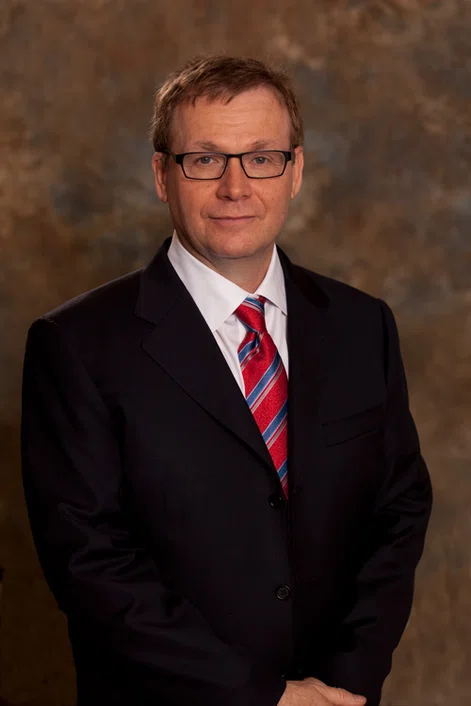


Restorative Medicine
Houston Methodist and Rice Launch Neuroprosthetics Collaboration
New center to focus on restoring brain function after disease or injury

Houston Methodist and Rice create Center for Translational Neural Prosthetics and Interfaces - using neurorobotics to restore function due to brain trauma or disease
Neurosurgery’s history of cutting diseases out of the brain is morphing into a future in which implanting technology into the brain may help restore function, movement, cognition and memory after patients suffer strokes, spinal cord injuries and other neurological disorders. Rice University and Houston Methodist have forged a partnership to launch the Center for Translational Neural Prosthetics and Interfaces, a collaboration that brings together scientists, clinicians, engineers and surgeons to solve clinical problems with neurorobotics.

Gavin W. Britz, MD
Candy and Tom Knudson Distinguished Centennial Chair, Department of Neurosurgery
Professor of Neurosurgery
Director, Neurological Institute
Co-Director, Center for Translational Prosthetics and Interfaces
Houston Methodist
Houston Methodist neurosurgeons, seven engineers from the Rice Neuroengineering Initiative and additional physicians and faculty from both institutions form the center's core team. The center also plans to hire three additional engineers who will have joint appointments at Houston Methodist and Rice. Key focus areas include spinal cord injury, memory and epilepsy studies, and cortical motor/sensation conditions.
“The Rice Neuroengineering Initiative was formed with this type of partnership in mind,” said center co-director Behnaam Aazhang, PhD, Rice's J.S. Abercrombie Professor of Electrical and Computer Engineering, who also directs the neuroengineering initiative, which launched in 2019 to bring together the brightest minds in neuroscience, engineering and related fields to improve lives by restoring and extending the capabilities of the human brain. “Several core members, myself included, have existing collaborations with our colleagues at Houston Methodist in the area of neural prosthetics. The creation of the Center for Translational Neural Prosthetics and Interfaces is an exciting development toward achieving our common goals.”
The physical space for the center’s operation includes more than 25,000 square feet of Rice Neuroengineering Initiative laboratories and experimental spaces in the university's BioScience Research Collaborative, as well as an extensive build-out underway at Houston Methodist’s West Pavilion location that’s expected to be completed late this year. The Houston Methodist facility will include operating rooms and a human laboratory where ongoing patient/volunteer diagnosis and assessment, device fabrication and testing, and education and training opportunities are planned.
This will be an accelerator for discovery. This center will be a human laboratory where all of us — neurosurgeons, neuroengineers, neurobiologists — can work together to solve biomedical problems in the brain and spinal cord. And it’s a collaboration that can finally offer some hope and options for the millions of people worldwide who suffer from brain diseases and injuries.”

Gavin W. Britz, MD
Candy and Tom Knudson Distinguished Centennial Chair, Department of Neurosurgery
Professor of Neurosurgery
Director, Neurological Institute
Co-Director, Center for Translational Prosthetics and Interfaces
Houston Methodist
“This partnership is a perfect blend of talent,” said Rice's Marcia O’Malley, PhD, a core member of both the new center and university initiative and the Thomas Michael Panos Family Professor in Mechanical Engineering. “We will be able to design studies to test the efficacy of inventions and therapies and rely on patients and volunteers who want to help us test our ideas. The possibilities are limitless.”
Houston Methodist neurobiologist Philip J. Horner, PhD, describes the lab as “a merging of wetware with hardware,” where robotics, computers, electronic arrays and other technology — the hardware — is incorporated into the human brain or spinal cord — the wetware. The centerpiece of this working laboratory is a zero-gravity harness connected to a walking track, with cameras and sensors to record feedback, brain activity and other data.
While the Houston Methodist space is being built, collaborations already are underway between the two institutions, which sit across Main Street from one another in the Texas Medical Center. Among them are the following:
• O’Malley and Houston Methodist’s Dimitry Sayenko, MD, PhD, assistant professor of neurosurgery, will head the first pilot project involving the merging of two technologies to restore hand function following a spinal cord injury or stroke. O’Malley will pair the upper limb exoskeleton she invented with Sayenko’s noninvasive stimulator designed to wake up the spinal cord. Together, they hope these technologies will help patients achieve a more extensive recovery — and at a faster pace.
• Rice neuroengineer Lan Luan, PhD, assistant professor of electrical and computer engineering, and Britz, a neurosurgeon, are collaborating on a study to measure the neurovascular response following a subarachnoid hemorrhage, a life-threatening stroke caused by bleeding just outside the brain. Two-thirds of people who suffer these brain bleeds either die or end up with permanent disabilities. Luan invented very small and flexible electrodes that can be implanted in the brain to measure, record and map its activities. Her work with mice could lead to human brain implants that may help patients recover from traumatic brain injuries caused by disease or accidents.
• Aazhang, Britz and Taiyun Chi, PhD, assistant professor of electrical and computer engineering at Rice, are collaborating on the detection of mild traumatic brain injuries from multimodal observations and on alleviating mTBI using neuromodulations. This project is of particular interest to the Department of Defense.
- Patti Muck, April 2021
Patti Muck, April 2021








